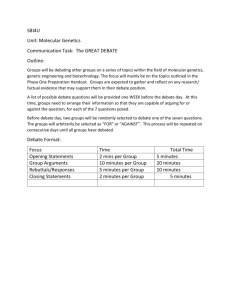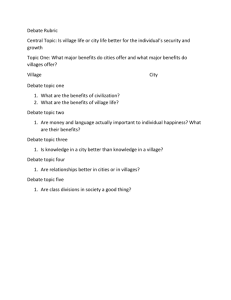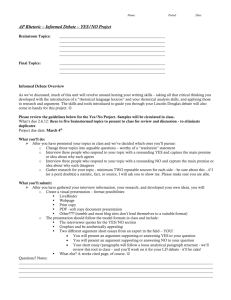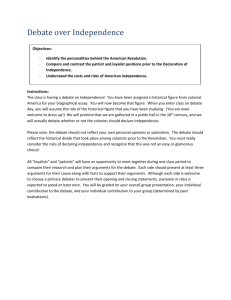Classroom Debates
advertisement
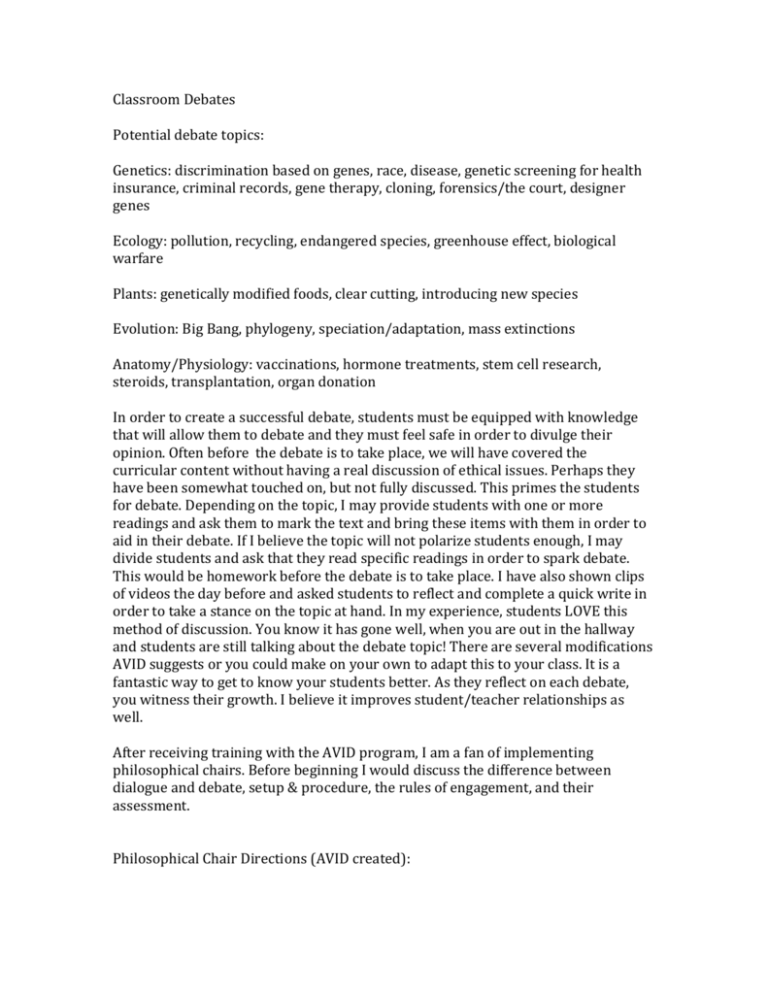
Classroom Debates Potential debate topics: Genetics: discrimination based on genes, race, disease, genetic screening for health insurance, criminal records, gene therapy, cloning, forensics/the court, designer genes Ecology: pollution, recycling, endangered species, greenhouse effect, biological warfare Plants: genetically modified foods, clear cutting, introducing new species Evolution: Big Bang, phylogeny, speciation/adaptation, mass extinctions Anatomy/Physiology: vaccinations, hormone treatments, stem cell research, steroids, transplantation, organ donation In order to create a successful debate, students must be equipped with knowledge that will allow them to debate and they must feel safe in order to divulge their opinion. Often before the debate is to take place, we will have covered the curricular content without having a real discussion of ethical issues. Perhaps they have been somewhat touched on, but not fully discussed. This primes the students for debate. Depending on the topic, I may provide students with one or more readings and ask them to mark the text and bring these items with them in order to aid in their debate. If I believe the topic will not polarize students enough, I may divide students and ask that they read specific readings in order to spark debate. This would be homework before the debate is to take place. I have also shown clips of videos the day before and asked students to reflect and complete a quick write in order to take a stance on the topic at hand. In my experience, students LOVE this method of discussion. You know it has gone well, when you are out in the hallway and students are still talking about the debate topic! There are several modifications AVID suggests or you could make on your own to adapt this to your class. It is a fantastic way to get to know your students better. As they reflect on each debate, you witness their growth. I believe it improves student/teacher relationships as well. After receiving training with the AVID program, I am a fan of implementing philosophical chairs. Before beginning I would discuss the difference between dialogue and debate, setup & procedure, the rules of engagement, and their assessment. Philosophical Chair Directions (AVID created): 1. A statement is presented to the students. The statement will divide students into one of three groups: pro, con, or undecided. The statement could be one surrounding a topic currently discussed in class or based on a reading. 2. Before beginning, students receive a handout that must be completed as part of their evaluation. Before the debate begins, student must write down the topic, decide if they agree or disagree, and write a brief paragraph explaining why they agree or disagree. 3. Those who agree with the central statement sit on one side and those who disagree sit on the other side. The pro/con chairs are facing each other, while the undecided chairs are placed in-between the pro/con chairs, but facing the front of the classroom. 4. The mediator (teacher) will remain neutral and ensure the rules of engagement are followed. Eventually this role will fall on a student. Part of the job of the mediator is to ensure participation by as many students as possible and to keep just a few students from dominating the discussion. The mediator may also put a time limit on how long each side addresses the issue on each turn. 5. In addition to speaking in the discussion, students may express their opinions by moving from one side to other. Anyone may change seats at any time. Changing seats does not necessarily mean that a person’s mind is changed, but rather that argument made is compelling enough to sway the opinions. Students may move back and forth through-out the discussion. 6. The discussion and movement go on for a designated period of time usually one class period. The mediator may bring the discussion to a close at any time. Each side may be given an opportunity to make a final statement on the issue. If time allows, each participant states his/her final opinion and may also tell which arguments he/she found most convincing. 7. If the argument becomes stale or it stalls in any way, the mediator may add to the discussion. Also, the mediator is responsible for making sure students are clear on the points opposing sides are making. Evaluation Students will reflect on the activity before leaving the classroom. A handout will be provided. I have attached the assessment I will use in the next post regarding the debate on genetically modified foods. Rules of Engagement (AVID created) Be sure you understand the central statement or topic before the discussion begins. Decide which section you will sit in. Listen carefully when others speak and seek to understand their arguments even if you don’t agree. Wait for the mediator to recognize you before you speak; only one person speaks at a time. You must first summarize briefly the previous speaker’s argument before you make your response. If you have spoken for your side, you must wait until three other people on your side speak before you speak again. Be sure that when you speak, you address the ideas, not the person stating them. Keep an open mind and move to the other side or the undecided section if you feel that someone made a good argument or your opinion is swayed. Support the mediator by maintaining order and helping the discussion to progress. 1. What are some STSE topics that would be ideal for classroom debates in the course you will teach? In SBI3U, some debate topics that would be ideal for classroom debates are: A: Diversity of Living Things • pollution • recycling • conservation • endangered species • greenhouse effect • disease control • biological warfare B: Evolution • Big Bang (Origin of Universe) • Mass extinctions • Hominid Lineage • Darwinian Evolution • Speciation and Adaptation C: Genetic Processes • discrimination based on genes, race, disease • genetic screening for insurance • criminal records • gene therapy • cloning, forensics and the court (DNA record keeping, testing for HIV are these constitutional?) • Designer genes D: Animals: Structure and Function • organ donation • transplantation • stem cells • athletics/ steroids • vaccinations and immunity • hormone treatment E: Plants: Anatomy, Growth and Functions • genetically engineered foods • relationships between angiosperms and herbivores • introducing non indigenous specie • clear cutting and timber 2. How does a teacher run an effective classroom debate? Give a step by step guide for the process you would follow to set up, mediate and assess a class period or portion of a class period devoted to a classroom debate. In order to run an effective classroom debate, you want the students to believe in their argument and instill confidence and for that to happen, it’s important to keep it professional. 1. Hand out debate guideline sheet and go through guidelines with students: a. How to prepare i. Research topic, gather evidence, set up persuasive arguments ii. Practice b. During debate i. Summarize after each speaking opportunity ii. Listen carefully to opposition team, take down points c. How to win i. Will be marked on quality of evidence d. Timeline of debate i. Who speaks first, how long etc. e. Hand out rubric and go through it f. Assign groups 2. Day of presentation a. Go over proceedings b. Remind points from rubric – how students will be marked c. Emphasize respectfulness d. mediate and use rubric to assess student work e. ask students to do a self assessment on debate and hand in Some possible topics for debates in Biology are: evolution theory, human manipulation of species, genetic manipulation in plants, animals and humans, organ transplants, the role of pharmaceutical companies in medical treatments, use of technology to sustain life, human effects on ecosystems. ‘Proper’ debating is a very organised and formal process. Personally, I am more interested in the skills inherent in debate (e.g. framing an argument, coherently opposing a particular point etc.) rather than having the students know how to observe the ‘official’ codes of behaviour. For this reason, I think I would modify the debate procedure to allow focus on the enduring understanding rather than knowledge of protocol. While I have submitted a relatively standard debate as an assignment for this course (and believe this would be useful sometimes), I would be inclined to play with the format and, perhaps, allow extra time (even homework) between proposition and oppositions to allow students to frame coherent responses and deepen their knowledge. While debates provide an opportunity to argue from alternative perspectives that you don’t necessarily subscribe to, I think there is also value in allowing students to argue the position that they do believe to provide a more authentic experience. There is greater learning to be gained from someone arguing what they really believe in than someone playing a role. I realise that there may not always be someone ready to argue ‘other’ side, but maybe that can be avoided with careful selection of the topic and/or motion. I realise that this position could be controversial with hardcore debaters, and I do value debate in its ‘real’ format as an activity students can pursue if it is their passion. However, I think a modified form is more appropriate in the Science classroom. Debate in the classroom should be about gaining deeper understanding of the issues, not learning the formal rules of debating.


